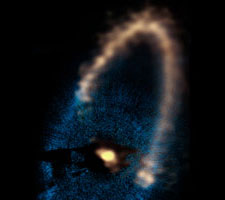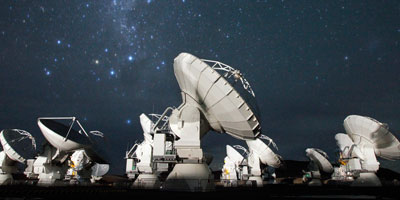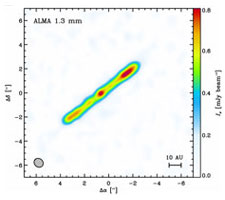AAS Plenary Session
The Atacama Large Millimeter/submillimeter Array: A New Window on the Universe
 | Plenary Talk by Tony Beasley (NRAO Director) American Astronomical Society 222nd meeting - Indianapolis, IN Tuesday 4 June 2013 11:40 – 12:30 EDT Wabash Ballroom 1, Indiana Convention Center |
|---|



Download Tony Beasley's plenary session presentation [Note: The file size is 1.3 GB]
The Atacama Large Millimeter/submillimeter Array (ALMA) is the largest ground-based global astronomy endeavor in history. Composed of 66 high-precision antennas located on an excellent site at 5000m+ elevation on the Chajnantor plateau in northern Chile, ALMA is delivering the astronomy community orders of magnitude improvements in millimeter-wavelength sensitivity, frequency coverage, resolution, imaging, and spectral capabilities, impacting most fields of astrophysics and opening multiple new scientific frontiers. ALMA’s capabilities span wavelengths from 9.6 to 0.3 mm (31-950 GHz), a key part of the electromagnetic spectrum for observing the first stars and galaxies, directly imaging planetary formation, and studying the energy output from supermassive black holes in starburst galaxies. ALMA’s inauguration on 13 March 2013 marked the Project’s transition to operation as a fully-fledged Observatory.
This session will review ALMA’s origins and history, current technical capabilities, and describe its primary scientific goals. Innovative aspects of its design, construction, operation, and governance will be highlighted, including the key roles of the North American ALMA Science Center at the National Radio Astronomy Observatory in Charlottesville, Virginia and the Joint ALMA Observatory in Chile. Development of the state- of-the-art technologies that are enabling the highest impact science will be described. Science operations were initiated 30 September 2011, and research results will be presented from both the Cycle 0 and Cycle 1 Early Science opportunities. This session will conclude with the vision for the Development Program that will maintain ALMA’s capabilities at the forefront of modern astronomy.
ALMA is a partnership of North America, Europe, and East Asia in cooperation with the Republic of Chile. ALMA is funded in North America by the U.S. National Science Foundation, in cooperation with the National Research Council of Canada, and the National Science Council of Taiwan.




Connect with NRAO